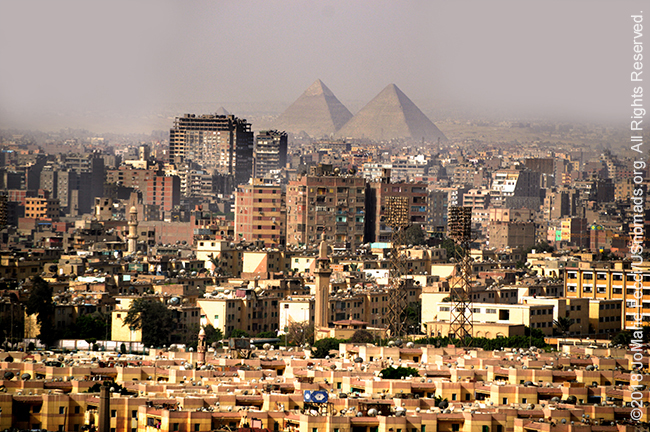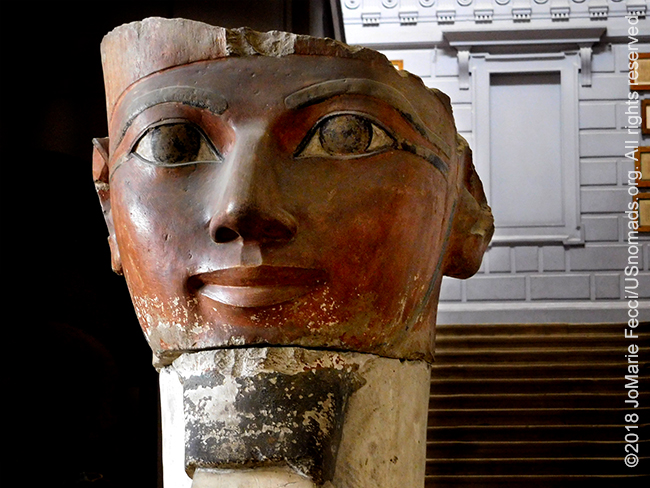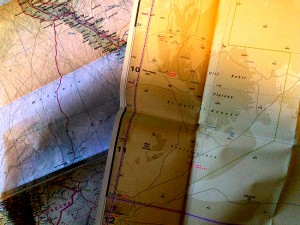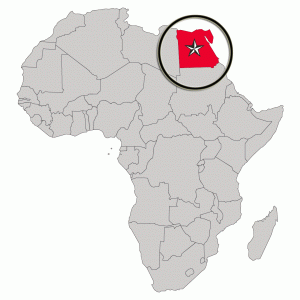
CAIRO, EGYPT (29 March 2018) — The dust had cleared somewhat by morning and I got my introduction to Cairo traffic, which really IS worse than New York city’s chaos. There is a level of aggression in the driving here mixed in with a sort of lawlessness that means anything can come at you from any direction (and at any time) and roads don’t really have defined “lanes” even if there are lines painted on the tarmac. Still, the local drivers know how to navigate it and hesitant foreigners are the bigger road hazard.
Today was an orientation day for getting to know a bit of the modern city and also an introduction to ancient Egypt and the history connecting the two. I am traveling for a couple of days with an expert Egyptologist, Nahla Elkhadi, who is attempting the Herculean task of giving me a historical framework for understanding 5,000 years of civilization in two days time before I leave for the desert. We started with a physical overview of Cairo, from the Citadel up on the Mokattam hill. From this high point it was possible to look out over a sprawling metropolis that seemed poised to swallow up the ancient pyramids on its outskirts. The Citadel itself is a protected UNESCO monument — a medieval Islamic fortification founded by Saladin with an Ottoman-era mosque constructed by Muhammad Ali Pasha based on the design of Istanbul’s Blue Mosque.
The Citadel has an interesting history and though it is best known for the “massacre of the Mamluks” it actually was the center of some very positive changes for ordinary Egyptians during the Muhammad Ali period. The welfare of local populations had never been very high on the Ottomans’ priority list, but Muhammad Ali instituted dramatic reforms in the military, economic and cultural spheres that improved people’s lives and he is regarded by many as the founder of modern Egypt.
From the heights of the Citadel we returned to modern Cairo just long enough to drive to the Egyptian Museum which houses the extensive collection of antiquities from ancient Egypt. The security procedure for entering all these touristic sites is thorough, beginning with a checkpoint outside the perimeter for vehicles entering the parking area where a K-9 unit examines each vehicle for explosives. Individual visitors are then run through an airport-like security screening with the familiar x-ray for belongings and metal detector for people, prior to entering the sites themselves.
The antiquities museum contains the world’s largest collection of Pharaonic artifacts and is home to the “Treasures of Tutankhamun“. We did not have time for an exhaustive museum visit, but Nahla wanted to familiarize me with some of the key stylistic differences between artifacts from the Old, Middle and New Kingdoms. The chronological display of the collection made it easier to walk me through the historical overview beginning with the first concrete evidence of the unification of Upper and Lower Egypt through the peak of Pharonic power to its eventual decline and fade out under a series of invasions and conquerors.
We stopped to view specific examples that highlighted some of the most important aspects that defined each period’s work. The incredibly detailed realism of the Old Kingdom depictions gave way to cruder more stylized images in the early Middle Kingdom, probably due to a loss of skilled artisans during the chaotic period between the “kingdoms,” but the faces became much more “expressive.” New Kingdom artifacts show Egypt at the peak of her power with the most elaborate decorative art in funerary temples. The “crash course” in ancient Egypt gave me a basic framework for beginning to understand what I am looking at in its proper historical context. But “historical context” doesn’t explain away the primordial fascination we have with these objects.
A quick visit to the Tutankhamun collection reminded me of my own childhood interest in all things Egyptian, and the first time I saw many of these same artifacts when they were on loan to the Metropolitan Museum of Art in New York. And now here I am, full-circle, set to embark on my own Egyptian exploration…

ABOUT THE EXPEDITION

JoMarie Fecci, of USnomads, sets off on an independent scouting trip across Egypt and Sudan in preparation for an up-coming Sahara expedition. Driving locally-sourced Toyotas and working with small local teams in each region, she will traverse a winding route that jumps off from key points along the Nile as far south as Khartoum, where the Blue and White Niles meet. During the journey she will visit a series of UNESCO world heritage sites focused on the ancient civilizations that occupied the region and meet with local communities. The primary goal of this mission is to assess terrain, security, driving conditions, logistical concerns and approximate timeframes for future travel.
WHERE WE ARE

The Arab Republic of Egypt, is a transcontinental country spanning the northeast corner of Africa and southwest corner of Asia by a land bridge formed by the Sinai Peninsula. With the Mediterranean sea on its northern border, the Gulf of Aqaba to the east, and the Red Sea to the east and south, it occupies a geo-strategic location connecting Europe, Asia and Africa. It has land borders with Gaza and Israel to the east, Sudan to the south, and Libya to the west. Islam is the official religion and Arabic the official language. Egypt is the most populous country in North Africa and the Arab world, with over 95 million inhabitants. Most of the population lives near the banks of the Nile River, in an area of about 40,000 square kilometres (15,000 sq mi), where the only arable land is found. The large regions of the Sahara desert, which constitute most of the country’s territory, are sparsely inhabited. Considered a cradle of civilization, Egypt emerged as one of the world’s first nation states in the tenth millennium BC and iconic monuments such as the Giza Necropolis and its Great Sphinx, as well the ruins of Memphis, Thebes, Karnak, and the Valley of the Kings, reflect this legacy.